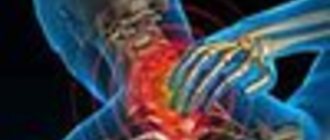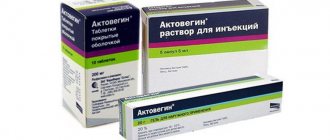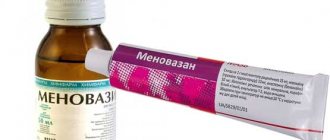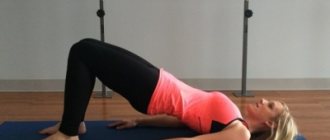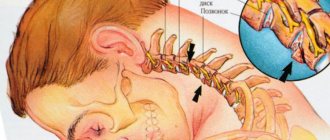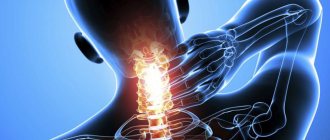Every year the diagnosis of osteochondrosis becomes younger. It is increasingly being diagnosed in schoolchildren and students, and young people suffer from manifestations of radicular syndrome, which seriously complicates their lives. Headache, discomfort in the upper back and neck, decreased vision and hearing, migraines and deterioration of cognitive abilities are the main consequences of cerebral circulation disorders in cervical osteochondrosis. It is important not only to increase blood flow, but also to restore the intervertebral joints. How to improve cerebral circulation with cervical osteochondrosis? The article presents 8 groups of drugs for this purpose, and also provides recommendations for special gymnastics, the regular implementation of which will help improve well-being.
What to choose - traditional methods of treatment or therapy with pharmaceutical drugs?
Cervical osteochondrosis can result in serious suffering for the patient. A sedentary lifestyle, significant excess weight, spinal injuries, and staying in one position for a long time sooner or later lead to abrasion of the intervertebral discs, as a result of which the spinal nerves are pinched. This process can be accompanied by radicular syndrome and also lead to many other pathologies. They may not be externally related to osteochondrosis, but any experienced neurologist will instantly understand “where the legs grow from” in this or that pathology. Every patient with this diagnosis should know how to improve cerebral circulation with cervical osteochondrosis. If symptoms worsen, then it’s time to start a course of treatment.
Symptoms of cervical osteochondrosis, which can increase as cerebral circulation is impaired and the spinal nerve is pinched:
- At the first stage - frequent dizziness, darkening of the eyes, which intensifies when turning the head in different directions. Vision or hearing may deteriorate for no apparent reason, headaches may often occur, constant ringing in the ears, numbness of the tongue, loss of coordination, and decreased performance may begin.
- At the second stage, the patient begins to experience more pain in the neck and shoulders, sometimes radiating to the arms. The headache is more frequent and severe, and the pain partially goes away after a light massage of the cervical-collar area. All symptoms characteristic of the first stage gradually intensify.
- At the third stage, the danger is no longer just in poor circulation and pinched nerves, but also in the possibility of herniated intervertebral discs. As a result, the patient may partially lose mobility of the spine in the cervical region. Due to impaired blood circulation, intracranial pressure may increase, partial headaches, migraines with and without aura may begin.
- At the fourth stage, complete or partial destruction of the intervertebral discs occurs and their replacement with connective tissue. In this case, the patient partially loses his ability to work, suffers from severe pain, vision and hearing can sharply deteriorate to critical levels, and coordination also suffers.
It is possible to improve blood circulation in the brain with cervical osteochondrosis both with the help of medications and with the help of folk remedies. It is impossible to say with certainty that one method is better than another - all patients are individual, and the remedy that suits one may not suit another. The only exceptions are gymnastics and massage - these two methods guarantee improvement of cerebral circulation in cervical osteochondrosis for all patients, regardless of age, gender and stage of the disease. Usually, neurologists, in parallel with the massage course, give directions for physiotherapeutic procedures and exercise therapy. Taken together, such events always produce excellent results.
Some patients are wary of taking medications and purposefully choose exclusively traditional methods of treatment. This approach is quite dangerous, since most traditional methods of treatment are only partially effective. Gymnastics cannot be considered a folk method of treatment; its effectiveness has long been proven, and this method of therapy is classified as physiotherapeutic.
Treatment of cerebral circulation in cervical osteochondrosis should be comprehensive - only with this approach can the progression of the disease be slowed down and long-term remission achieved. After the alarming symptoms subside, you cannot give up - you need to take medications a couple of times a year and visit a physiotherapist’s office, otherwise the disease will make itself known again.
And a little about secrets
Have you ever experienced constant back pain, neck pain or unbearable joint pain? Judging by the fact that you are reading this article, you or your loved ones are already familiar with them personally. And of course you know firsthand what it is:
- Constant aching and sharp pain;
- Inability to move comfortably and easily;
- Constant tension in the muscles of the back and neck;
- Unpleasant crunching and clicking in the joints;
- Sharp shooting in the spine or causeless pain in the joints;
- Inability to sit in one position for a long time.
Antioxidants to improve overall circulation
Patients and doctors often underestimate the effect of antioxidants. Meanwhile, Mexidol, known to everyone and often prescribed for failure of cerebral circulation, belongs specifically to the group of antioxidants. “Tocopherol” should not be underestimated, and it should be purchased separately (and not as part of a vitamin-mineral complex):
- The release forms of the drug "Mexidol" are tablets and solution for intravenous administration. It is actively used in neurology as a means of improving cerebral circulation in cervical osteochondrosis. The drug is also prescribed for atherosclerosis, vegetative-vascular dystonia, as well as for cognitive impairment of various etiologies. Mexidol is also used in psychiatry to relieve alcohol withdrawal and post-withdrawal syndrome.
- “Tocopherol” can be taken both as part of vitamin-mineral complexes and separately in capsules. In the second case, it will be more effective, since nothing will interfere with its absorption. Vitamin E can slow down the aging process, it has a positive effect on metabolic processes, reduces the total number of platelets in the blood, and restores tissue respiration. When used in combination with nootropics and vasodilators, it can significantly alleviate the condition of a patient with cervical osteochondrosis.
Drugs that improve blood access to the brain
How to improve cerebral circulation with cervical osteochondrosis? The easiest way is to start taking medications that directly improve cerebral circulation.
- Cavinton is available in tablet form. When taken regularly, a vasodilating effect is achieved. There is also the drug Cavinton Forte, which contains twice as much active ingredient. When taken, side effects such as headache, dizziness, and drowsiness are possible. some patients, on the contrary, feel cheerful during the course of taking the drug and note an increase in performance.
- "Tanakan" is made from the plant extract of Ginkgo biloba. This plant is famous for its vasodilating effect. During treatment, patients note an improvement in their well-being - headaches go away, the person becomes cheerful, falls asleep and wakes up easier. "Tanakan" is indicated for use by patients with cervical osteochondrosis if they suffer from cerebrovascular accident.
Chondroprotectors
We use drugs for recovery
To restore the cartilage tissue of intervertebral discs in the complex therapy of osteochondrosis, drugs with chondroitin sulfate - chondroprotectors - are used. The main actions of chondroitin:
- stimulation of hyaluronic acid synthesis and strengthening of cartilage structure;
- maintaining moisture in the cartilage, increasing shock absorption;
- stimulation of calcium fixation in bones;
- slowing down the natural processes of bone resorption.
The building material of chondroitin sulfate is glucosamine, so medications often include a complex of these substances. The natural synthesis of chondroitin sulfate begins from glucosamine in cartilage.
Among the chondroprotectors, the most popular are Chondroxide, Arthra, Teraflex, and Biflex.
"Chondroxide"
The drug contains chondroitin sulfate, obtained from the trachea of cattle. Chondroxide is produced in the form of tablets and ointments for external use. It is recommended to treat the disease using both forms of medication. The optimal duration of therapy is 3-6 months, the duration of the course is determined by the doctor.
"Arthra"
The drug is produced in the form of tablets that contain chondroitin and glucosamine in equal proportions. The use of a chondroprotector allows you to reduce the dose of painkillers. The duration of drug therapy is 4-6 months.
"Arthra" is normally tolerated by the body; in rare cases, flatulence, bowel movements and dizziness may occur. The drug is contraindicated in pregnant women and patients with kidney dysfunction.
We advise you to study - Nicotinic acid for osteochondrosis
Therapy is prescribed with caution to patients with bronchial asthma and diabetes mellitus.
Nootropic drugs for cervical osteochondrosis
Nootropics can significantly improve the well-being of patients with osteochondrosis. The most frequently prescribed drugs:
- "Pantogam" (and its cheaper analogue called "Pantocalcin") today is prescribed even to children. While taking it, improvements in the cognitive sphere are observed, blood circulation is restored (partially or completely - depends on the degree of neurological disorders and diagnosis).
- It is advisable to take “Phenotropil” if, due to a cerebrovascular accident, the patient suffers from impaired attention, memory, and cannot concentrate. Patients who take Phenotropil note the appearance of vigor, vital activity, they are cheerful and efficient. The downside of the drug is its rather high cost (about a thousand rubles per package).
- "Cerebrolysin" is a drug in ampoules for intramuscular administration. The main active component is a peptide (extract from the brain of pigs), which in its structural formula resembles a human one. Typically, neurologists prescribe a course of ten to twenty injections daily. "Cerebrolysin" is a medicine that improves cerebral circulation in cervical osteochondrosis, after injuries and concussions, strokes, etc. This drug is also prescribed to children with delayed speech and mental development.
Varieties of myotropes
The main myotropic medications that are used for cervical osteochondrosis are:
- Eufillin. It has antispasmodic properties and improves peripheral blood circulation in the brain. Often used for electrophoresis, which also stabilizes blood flow. Produced in ampoules and tablets.
- Actovegin. Prescribed for the brain to improve vascular tone, facilitate oxygen access and activate metabolic processes.
- Pentoxifyline. It has an effect not only on the vascular wall, relaxing it, but also improves the quality of the blood itself, as a rule, preventing the formation of blood clots. As a result, the tissues receive more oxygen.
- Berlition (lipoic acid). Thanks to it, endoneurial blood flow increases, trophic processes in neurons improve, blood vessels dilate and all processes in cells are restored. In addition, this drug is an antioxidant.
- Cinnarizine. The medicine acts specifically on the wall with blood vessels, which leads to an increase in their lumen. Normalizes blood circulation and reduces blood viscosity. The product is available only in tablets.
- A nicotinic acid. Dilates small vessels while improving blood circulation. Stabilizes elevated cholesterol levels. It is most often used intramuscularly, less often - intravenously.
The use of drugs with a venotonic effect for osteochondrosis
Neurologists prescribe this category of drugs relatively rarely. Venotonics can strengthen the walls of veins and arteries and improve their tone. Good cerebral circulation in cervical osteochondrosis is rare; patients often need to use venotonics in a course if there is a tendency to thinning of the venous walls. The most popular drugs in this category are Phlebodia, Detralex, Escusan. The latter also has the ability to cause short-term dilation of blood vessels due to the presence of alcohol in the composition.
However, patients with cervical osteochondrosis are usually skeptical when a doctor prescribes a drug from the venotonic category. People far from medicine believe that this category of drugs promotes recovery only in cases of severe vein pathology. In fact, even relatively healthy people should take a course of venotonic drugs from time to time.
Operating principle
In the treatment of cervical osteochondrosis, drugs are used that act on the vasomotor center of the brain. Peripheral vasodilators are also included in treatment regimens. There are several groups depending on their pharmacological properties:
- reducing the tone of smooth muscle muscles, dilating blood and lymphatic vessels. This therapeutic effect is achieved by inhibiting sympathetic nerve fibers, reducing the production of hormones that provoke vasospasm;
- expanding the lumen of blood vessels by enhancing the influence of the parasympathetic nervous system;
- blocking receptors in the walls of arteries. Reducing the tone of smooth muscle fibers normalizes blood circulation.
Dr. Epifanov and cervical spine therapy:
A combination of vasodilators and nootropics helps restore blood supply to tissues. These drugs have a specific effect on the higher mental functions of the brain. With an integrated approach to the treatment of osteochondrosis, a diverse therapeutic effect can be achieved:
- activate blood circulation;
- expand the diameter of blood vessels;
- increase the functional activity of the brain;
- replenish reserves of microelements, bioactive and nutritional compounds;
- normalize the supply of brain cells with molecular oxygen.
A properly designed therapeutic regimen will speed up the patient’s recovery by stimulating metabolism in tissues that have undergone destruction. The walls of blood vessels are strengthened, the viscosity and fluidity of the blood is restored.
We advise you to study - “Nimesil”: reviews for osteochondrosis
Dr. Sperling's personal opinion:
| Vasodilators for the treatment of cervical osteochondrosis | Price of the medicine in rubles |
| Eufillin | Solution 0.024/ml, 5ml N10 - 60; Tablets 0.15 No. 30 - 30 |
| Pentoxifylline | Tablets 0.04 No. 20 - 270; Solution 0.02/ml, No. 10, 10 ml - 50 |
| A nicotinic acid | Solution 1% 1 ml No. 10 - 140; Tablets 0.5 No. 50 - 50 |
| Piracetam | Capsules 0.04 No. 60 - 120; Tablets 0.8 No. 30 - 70 |
| Vinpocetine | Tablets 0.01 No. 30 - 130; 0.005/ml, solution 2 ml No. 10 - 110 |
| Berlition | Tablets 0.3 No. 30 - 750 |
| Thiogamma | Tablets 0.6 No. 60 - 1600 |
| Octolipen | Capsules 0.3 No. 30 – 350 |
| Solcoseryl | 0.0425/ml, 2ml N25, solution for parenteral administration - 1800 |
| Actovegin | Tablets 0.2 No. 50 - 1500; Solution 0.04/ml, 10 ml N5 - 1100 |
Doctor prescribing diuretics and osmodiuretics for cervical osteochondrosis
This category of drugs is usually prescribed in cases where cervical osteochondrosis has led to increased intracranial pressure due to compression of the nerves. This symptom is characteristic of the later stages of the disease. If possible, it is better not to let the disease develop serious complications.
Taking diuretics for cerebral edema and increased intracranial pressure (usually prescribed Furosemide or Diacarb) promotes the outflow of excess fluid from all body tissues, including brain tissue. As a result, the pressure stabilizes and the patient feels better.
Histaminergic drugs for cervical osteochondrosis: what are they prescribed for?
These drugs are prescribed if poor circulation due to cervical osteochondrosis has led to a lack of coordination and problems with the vestibular apparatus. Histaminergic drugs help normalize blood circulation and the functioning of the inner ear, as a result of which the severity of unpleasant symptoms becomes less. After a course of treatment, dizziness and vestibular disorders may go away for a long time.
Drugs for cerebral circulation in cervical osteochondrosis, which are usually prescribed by a doctor for complaints of problems with coordination - Betaserc, Betagistin, Vestibo. They must be taken in a course of at least ten days. If the patient has parallel pathologies of cardiac activity, then Betaserc can be prescribed for a long period - about several months. Histaminergic drugs have a number of contraindications and side effects, so they should be taken in case of emergency and only after consultation with doctors - a neurologist and cardiologist.
Chondoprotectors for restoring articular surfaces and improving blood microcirculation
Tablets for cerebral circulation for cervical osteochondrosis should be taken regularly, in a course. Chondoprotectors are no exception to the rule. Since with cervical osteochondrosis, the layer between the vertebrae inevitably wears out and becomes thinner over time, the patient should take drugs with a chondoprotective effect at least once a year for at least one month. These are “Teraflex”, “Artron” or “Chondroitin”.
"Teraflex" is a combination drug with a chondoprotective effect. Sodium chondroitin sulfate (the main active component of Teraflex) is a high-molecular component directly involved in the formation of joints and cartilage. Indications for use of the drug: dystrophic changes in cartilage and joint tissue, chronic diseases of the musculoskeletal system (osteochondrosis, scoliosis, osteoarthritis, etc.).
"Chondroitin" contains chondroitin sulfate as the main active ingredient. This component is a high molecular weight polysaccharide that is involved in the formation of joint and cartilage tissue. Indicated for use in a wide variety of diseases of the musculoskeletal system, as well as periodontitis, periodontal disease and joint diseases of unknown etiology. The downside of the drug is its rather high cost (about one and a half thousand rubles per package).
Vitamin and mineral complexes
Preparations for cerebral circulation for cervical osteochondrosis containing B vitamins have long established themselves as a simple and reliable way to improve the patient’s condition. It has long been proven that when taken orally, B vitamins are not completely absorbed, but when administered intramuscularly, the necessary components enter directly into the bloodstream and rush to every corner of the body. Most often, neurologists prescribe the following drugs in the form of injections: Combilipen, Milgamma, Neuromultivit. You can buy ampoules of each vitamin separately - “Thiamin”, “Cyanocobalamin”, “Pyridoxine”. You can give yourself injections at home, or you can visit a doctor’s office at a clinic on a regular basis. The minimum course of injections for cervical osteochondrosis is ten days.
Pentovit can be used as tablets that improve cerebral circulation in cervical osteochondrosis. This drug contains the entire complex of B vitamins. Some neurologists prescribe a fairly high dosage, since it allows you to level out the difference between the amount of active substances that is completely absorbed by the body and the amount that came with the tablets. Patients with serious pathology should know how to improve blood circulation with cervical osteochondrosis. Preparations with B vitamins are a simple and affordable way to improve cerebral circulation and get rid of the symptoms that accompany this disorder.
Instructions for use and dosage of the medicine
The dosage and method of taking the drug depends on the disease and the form of the drug.
Mostly injections and infusions are used in the treatment of neuropathic conditions, and tablets are prescribed in all other cases, although exceptions are possible - this is decided by the doctor.
Pills
Recommended time of administration is early morning, 30 minutes before breakfast. The course of such therapy can last 2-4 weeks - depending on the disease, normalization of the condition and the speed of recovery of the body.
Sometimes, to maintain the body after the main course, they continue to take the drug once a day. This measure serves to prevent possible relapses and exacerbations.
Ampoules 300 and 600
The solution for infusion is dosed depending on the specific case. The doctor himself decides what dose of the drug the patient needs on an individual basis.
Most often, a drip with Berlition is placed for neuropathic lesions of alcoholic or diabetic origin. Although in case of severe poisoning or unconsciousness the patient is not able to take pills, then he is given an injection of Berlition 300 (ampoule per day).
To install the system, an ampoule of the drug is diluted with saline solution (250 ml). It is necessary to prepare such a solution only before infusion, otherwise it will quickly lose its therapeutic effect. Moreover, the already prepared infusion solution should not be allowed to come into contact with sunlight, so the bottle with the drug is usually wrapped in thick paper or foil.
Intramuscular administration of Berlition is allowed, but only according to a certain system that prohibits the introduction of more than 2 ml of a concentrated solution into one localization, in other words, to administer a 24 ml ampoule it is necessary to make 12 injections in different muscle areas.
Be careful when performing an infusion procedure that requires compliance with certain rules. To prepare an infusion solution, you need to dilute the contents of the drug ampoule (24 or 12 ml) in 250 ml of saline solution. In this case, the dropper should be administered slowly, no more than 1.7 ml/min. The concentrated solution can only be diluted with sterile saline solution. During the IV drip, the patient must be supervised by a health care worker, as there is a risk of developing anaphylaxis.
Practice shows that if the therapeutic dose is exceeded, patients experience the following symptoms:
- Convulsive muscle contractions;
- Death of musculoskeletal tissue;
- Cloudiness of consciousness;
- Increased body acidity (acidosis);
- Nausea and vomiting, headaches;
- Psychomotor stimulation;
- Decreased bone marrow function;
- A sharp drop in blood glucose, up to a coma of hypoglycemic origin;
- Excessive destruction of red blood cells (pathological hemolysis);
- Intravascular blood coagulation;
- Insufficient functionality of several organs.
If more than 10 g of thioctic acid is taken, severe intoxication develops, which can be fatal.
During pregnancy
It is prohibited to use any form of the drug in the treatment of pregnant and lactating women.
In combination with ethyl alcohol, poisoning of the body is possible, so simultaneous use of the drug with alcohol is contraindicated.
Interaction
- Simultaneous use with ethyl alcohol is unacceptable;
- When combined with drugs that lower glucose levels, Berlition enhances their therapeutic effect, therefore, when treating diabetics, it is necessary to regularly donate blood for sugar;
- Significantly reduces the effectiveness of Cisplastin (a highly toxic antitumor drug);
- Since α-lipoic acid reacts with iron, magnesium and calcium, taking medications with similar components and consuming dairy products is allowed 7-8 hours after using Berlition.


